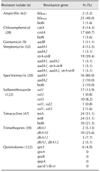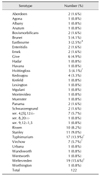1. Bangtrakulnonth A, Pornreongwong S, Pulsrikarn C, Sawanpanyalert P, Hendriksen RS, Lo Fo Wong DMA, Aarestrup FM. Salmonella serovars from humans and other sources in Thailand, 1993-2002. Emerg Infect Dis. 2004; 10:131–136.
2. Beceiro A, Tomás M, Bou G. Antimicrobial resistance and virulence: a successful or deleterious association in the bacterial world? Clin Microbiol Rev. 2013; 26:185–230.

3. Boerlin P, Travis R, Gyles CL, Reid-Smith R, Janecko N, Lim H, Nicholson V, McEwen SA, Friendship R, Archambault M. Antimicrobial resistance and virulence genes of
Escherichia coli isolates from swine in Ontario. Appl Environ Microbiol. 2005; 71:6753–6761.

4. Chen S, Cui S, McDermott PF, Zhao S, White DG, Paulsen I, Meng J. Contribution of target gene mutations and efflux to decreased susceptibility of
Salmonella enterica serovar Typhimurium to fluoroquinolones and other antimicrobials. Antimicrob Agents Chemother. 2007; 51:535–542.

5. Chen S, Zhao S, White DG, Schroeder CM, Lu R, Yang H, McDermott PF, Ayers S, Meng J. Characterization of multiple-antimicrobial-resistant
Salmonella serovars isolated from retail meats. Appl Environ Microbiol. 2004; 70:1–7.

6. Chiu CH, Ou JT. Rapid identification of
Salmonella serovars in feces by specific detection of virulence genes,
invA and
spvC, by an enrichment broth culture-multiplex PCR combination assay. J Clin Microbiol. 1996; 34:2619–2622.

7. Chu C, Chiu CH, Wu WY, Chu CH, Liu TP, Ou JT. Large drug resistance virulence plasmids of clinical isolates of
Salmonella enterica serovar Choleraesuis. Antimicrob Agents Chemother. 2001; 45:2299–2303.

8. Chuanchuen R, Ajariyakhajorn K, Koowatananukul C, Wannaprasat W, Khemtong S, Samngamnim S. Antimicrobial resistance and virulence genes in
Salmonella enterica isolates from dairy cows. Foodborne Pathog Dis. 2010; 7:63–69.

9. Chuanchuen R, Khemtong S, Padungtod P. Occurrence of qacE/qacEΔ1 genes and their correlation with class 1 integrons in Salmonella enterica isolates from poultry and swine. Southeast Asian J Trop Med Public Health. 2007; 38:855–862.
10. Chuanchuen R, Padungtod P. Antimicrobial resistance genes in
Salmonella enterica isolates from poultry and swine in Thailand. J Vet Med Sci. 2009; 71:1349–1355.

11. Clinical and Laboratory Standards Institute (CLSI). Performance Standards for Antimicrobial Disk and Dilution Susceptibility Tests for Bacteria Isolated from Animals; Approved Standard-Fourth edition. CLSI document VET01-04. Wayne: Clinical and Laboratory Standards Institute;2013.
12. D'Ortenzio E, Weill FX, Ragonneau S, Lebon JA, Renault P, Pierre V. First report of a Salmonella enterica serovar Weltevreden outbreak on Reunion Island, France, August 2007. Euro Surveill. 2008; 13:pii: 18949.
13. Ekkapobyotin C, Padungtod P, Chuanchuen R. Antimicrobial resistance of Campylobacter coli isolates from swine. Int J Food Microbiol. 2008; 128:325–328.
14. Fluit AC. Towards more virulent and antibiotic-resistant Salmonella? FEMS Immunol Med Microbiol. 2005; 43:1–11.
15. Galanis E, Lo Fo, Patrick ME, Binsztein N, Cieslik A, Chalermchikit T, Aidara-Kane A, Ellis A, Angulo FJ, Wegener HC. World Health Organization Global Salm-Surv. Web-based surveillance and global Salmonella distribution, 2000-2002. Emerg Infect Dis. 2006; 12:381–388.
16. Gordis L. Estimating risk: is there an association?. Epidemiology. 4th ed. Philadelphia: Saunders Elsevier;2009. p. 201–214.
17. Guardabassi L, Schwarz S, Lloyd DH. Pet animals as reservoirs of antimicrobial-resistant bacteria. J Antimicrob Chemother. 2004; 54:321–332.
18. Hasman H, Mevius D, Veldman K, Olesen I, Aarestrup FM. β-Lactamases among extended-spectrum β-lactamase (ESBL)-resistant
Salmonella from poultry, poultry products and human patients in The Netherlands. J Antimicrob Chemother. 2005; 56:115–121.

19. Heinitz ML, Ruble RD, Wagner DE, Tatini SR. Incidence of Salmonella in fish and seafood. J Food Prot. 2000; 63:579–592.
20. Herrero A, Rodicio MR, González-Hevia MA, Mendoza MC. Molecular epidemiology of emergent multidrug-resistant
Salmonella enterica serotype Typhimurium strains carrying the virulence resistance plasmid pUO-StVR2. J Antimicrob Chemother. 2006; 57:39–45.

21. Hsu SC, Chiu TH, Pang JC, Hsuan-Yuan CH, Chang GN, Tsen HY. Characterisation of antimicrobial resistance patterns and class 1 integrons among
Escherichia coli and
Salmonella enterica serovar Choleraesuis strains isolated from humans and swine in Taiwan. Int J Antimicrob Agents. 2006; 27:383–391.

22. International Organization for Standardization (ISO). ISO 6579:2002(en). Microbiology of food and animal feeding stuffs-Horizontal method for the detection of Salmonella spp. Geneva: International Organization for Standardization;2002.
23. Jay-Russell MT, Hake AF, Bengson Y, Thiptara A, Nguyen T. Prevalence and characterization of Escherichia coli and Salmonella strains isolated from stray dog and coyote feces in a major leafy greens production region at the United States-Mexico border. PLoS One. 2014; 9:e113433.
24. Khemtong S, Chuanchuen R. Class 1 integrons and
Salmonella genomic island 1 among
Salmonella enterica isolated from poultry and swine. Microb Drug Resist. 2008; 14:65–70.

25. Lay KK, Koowattananukul C, Chansong N, Chuanchuen R. Antimicrobial resistance, virulence, and phylogenetic characteristics of
Escherichia coli isolates from clinically healthy swine. Foodborne Pathog Dis. 2012; 9:992–1001.

26. Leonard EK, Pearl DL, Finley RL, Janecko N, Reid-Smith RJ, Peregrine AS, Weese JS. Comparison of antimicrobial resistance patterns of
Salmonella spp. and
Escherichia coli recovered from pet dogs from volunteer households in Ontario (2005-06). J Antimicrob Chemother. 2012; 67:174–181.

27. Lévesque C, Piché L, Larose C, Roy PH. PCR mapping of integrons reveals several novel combinations of resistance genes. Antimicrob Agents Chemother. 1995; 39:185–191.

28. Li R, Lai J, Wang Y, Liu S, Li Y, Liu K, Shen J, Wu C. Prevalence and characterization of
Salmonella species isolated from pigs, ducks and chickens in Sichuan Province, China. Int J Food Microbiol. 2013; 163:14–18.

29. Lin D, Chen K, Wai-Chi Chan E, Chen S. Increasing prevalence of ciprofloxacin-resistant food-borne
Salmonella strains harboring multiple PMQR elements but not target gene mutations. Sci Rep. 2015; 5:14754.

30. Ling JM, Chan EW, Lam AW, Cheng AF. Mutations in topoisomerase genes of fluoroquinolone-resistant salmonellae in Hong Kong. Antimicrob Agents Chemother. 2003; 47:3567–3573.

31. Marshall BM, Levy SB. Food animals and antimicrobials: impacts on human health. Clin Microbiol Rev. 2011; 24:718–733.

32. Park CH, Robicsek A, Jacoby GA, Sahm D, Hooper DC. Prevalence in the United States of
aac(
6′)-
Ib-
cr encoding a ciprofloxacin-modifying enzyme. Antimicrob Agents Chemother. 2006; 50:3953–3955.

33. Pedersen K, Pedersen K, Jensen H, Finster K, Jensen VF, Heuer OE. Occurrence of antimicrobial resistance in bacteria from diagnostic samples from dogs. J Antimicrob Chemother. 2007; 60:775–781.

34. Piddock LJ, Ricci V, McLaren I, Griggs DJ. Role of mutation in the
gyrA and
parC genes of nalidixic-acid-resistant
Salmonella serotypes isolated from animals in the United Kingdom. J Antimicrob Chemother. 1998; 41:635–641.

35. Robicsek A, Jacoby GA, Hooper DC. The worldwide emergence of plasmid-mediated quinolone resistance. Lancet Infect Dis. 2006; 6:629–640.

36. Rushdy AA, Mabrouk MI, Abu-Sef FAH, Kheiralla ZH, Abdel-All SM, Saleh NM. Contribution of different mechanisms to the resistance to fluoroquinolones in clinical isolates of
Salmonella enterica. Braz J Infect Dis. 2013; 17:431–437.

37. Sackett DL, Deeks JJ, Altman DG. Down with odds ratios. Evid Based Med. 1996; 1:164–166.
38. Sahm DF, Thornsberry C, Mayfield DC, Jones ME, Karlowsky JA. Multidrug-resistant urinary tract isolates of
Escherichia coli: prevalence and patient demographics in the United States in 2000. Antimicrob Agents Chemother. 2001; 45:1402–1406.

39. Seepersadsingh N, Adesiyun AA, Seebaransingh R. Prevalence and antimicrobial resistance of
Salmonella spp. in non-diarrhoeic dogs in Trinidad. J Vet Med B Infect Dis Vet Public Health. 2004; 51:337–342.

40. Skyberg JA, Logue CM, Nolan LK. Virulence genotyping of Salmonella spp. with multiplex PCR. Avian Dis. 2006; 50:77–81.
41. Stephenson S, Brown PD, Holness A, Wilks M. The emergence of qnr-mediated quinolone resistance among Enterobacteriaceae in Jamaica. West Indian Med J. 2010; 59:241–244.
42. Strahilevitz J, Jacoby GA, Hooper DC, Robicsek A. Plasmid-mediated quinolone resistance: a multifaceted threat. Clin Microbiol Rev. 2009; 22:664–689.

43. Thong KL, Goh YL, Radu S, Noorzaleha S, Yasin R, Koh YT, Lim VKE, Rusul G, Puthucheary SD. Genetic diversity of clinical and environmental strains of
Salmonella enterica serotype Weltevreden isolated in Malaysia. J Clin Microbiol. 2002; 40:2498–2503.

44. Torkan S, Khamesipour F, Anyanwu MU. Detection of virulence and antibacterial resistance genes in Salmonella isolates from diarrhoeic dogs in Iran. Rev Med Vet (Toulouse). 2015; 166:221–228.
45. Tsai HJ, Huang HC, Lin CM, Lien YY, Chou CH. Salmonellae and campylobacters in household and stray dogs in northern Taiwan. Vet Res Commun. 2007; 31:931–939.

46. Ulaya W, Hang'ombe BM, Zulu V, Nalubamba K, Mulenga E, Isogai H, Isogai E. Distribution of virulence genes and antimicrobial susceptibility of
Salmonella isolated from dogs and chickens in Zambia. Int J Agro Vet Med Sci. 2012; 6:360–367.

47. Wannaprasat W, Padungtod P, Chuanchuen R. Class 1 integrons and virulence genes in
Salmonella enterica isolates from pork and humans. Int J Antimicrob Agents. 2011; 37:457–461.

48. Yamane K, Wachino J, Suzuki S, Arakawa Y. Plasmid-mediated
qepA gene among
Escherichia coli clinical isolates from Japan. Antimicrob Agents Chemother. 2008; 52:1564–1566.

49. Zgurskaya HI, Nikaido H. Bypassing the periplasm: reconstitution of the AcrAB multidrug efflux pump of
Escherichia coli. Proc Natl Acad Sci U S A. 1999; 96:7190–7195.









 Citation
Citation Print
Print



 XML Download
XML Download